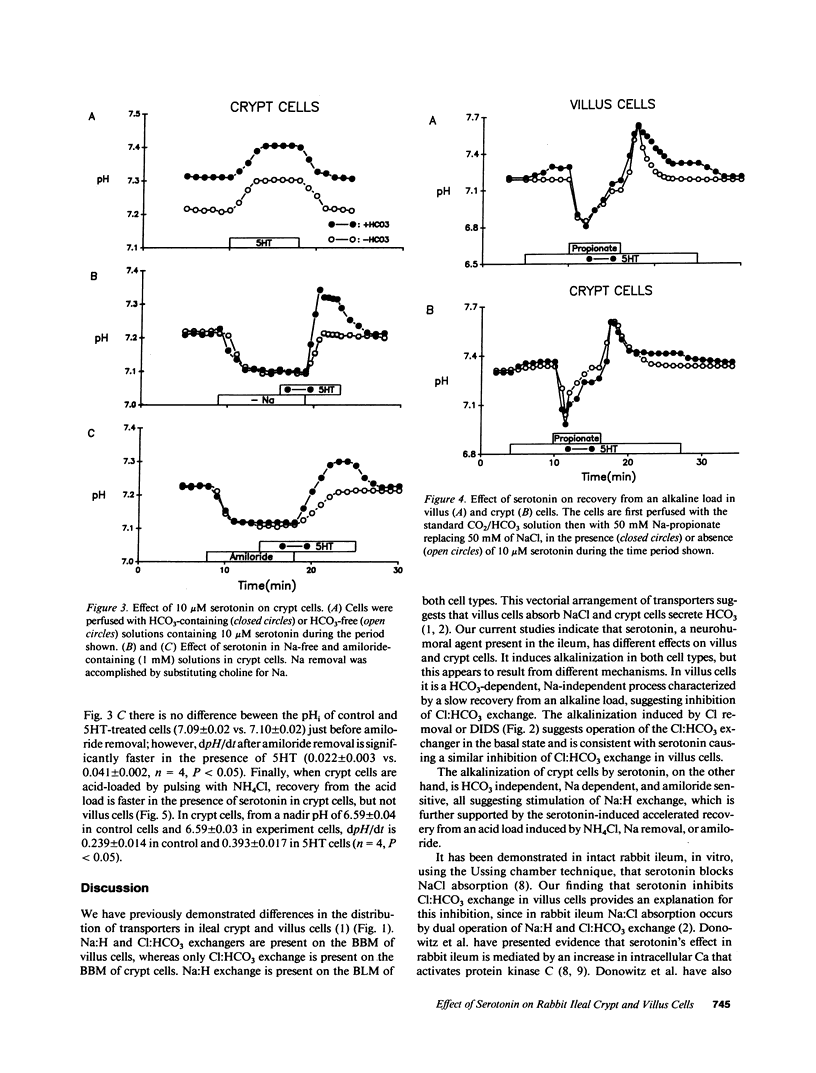Abstract
To determine the mechanism of action of an intestinal secretagogue, serotonin, we have isolated crypt and villus cells and demonstrated Na:H and Cl:HCO3 exchange activity using the intracellular pH-sensitive fluorescent dye, 2,7-bis (carboxy-ethyl)-5,6-carboxy-fluorescein. Serotonin alkalinized both crypt and villus cells. Alkalinization in villus cells was HCO3 dependent and Na independent. In contrast, alkalinization in crypt cells was HCO3 independent and Na dependent. In villus cells, recovery from an alkaline load induced by Cl removal, 4,4'-diisothiocyanatostilbene-2,2'-disulfonic acid or propionate pulse, known to occur via the Cl:HCO3 exchange, is inhibited by serotonin. In contrast, in crypt cells, recovery from an acid load induced by Na removal, amiloride and NH4Cl pulse, known to occur via Na:H exchange, is stimulated by serotonin. These data suggest that serotonin is inhibiting Cl:HCO3 exchange in villus cells and stimulating Na:H exchange in crypt cells. These effects of serotonin would be expected to inhibit coupled Na and Cl absorption by villus cells and stimulate HCO3 secretion by crypt cells in the intact ileum.
Full text
PDF



Selected References
These references are in PubMed. This may not be the complete list of references from this article.
- Banwell J. G., Pierce N. F., Mitra R. C., Brigham K. L., Caranasos G. J., Keimowitz R. I., Fedson D. S., Thomas J., Gorbach S. L., Sack R. B. Intestinal fluid and electrolyte transport in human cholera. J Clin Invest. 1970 Jan;49(1):183–195. doi: 10.1172/JCI106217. [DOI] [PMC free article] [PubMed] [Google Scholar]
- Dharmsathaphorn K., Mandel K. G., Masui H., McRoberts J. A. Vasoactive intestinal polypeptide-induced chloride secretion by a colonic epithelial cell line. Direct participation of a basolaterally localized Na+,K+,Cl- cotransport system. J Clin Invest. 1985 Feb;75(2):462–471. doi: 10.1172/JCI111721. [DOI] [PMC free article] [PubMed] [Google Scholar]
- Donowitz M., Asarkof N., Pike G. Calcium dependence of serotonin-induced changes in rabbit ileal electrolyte transport. J Clin Invest. 1980 Aug;66(2):341–352. doi: 10.1172/JCI109862. [DOI] [PMC free article] [PubMed] [Google Scholar]
- Donowitz M., Cohen M. E., Gould M., Sharp G. W. Elevated intracellular Ca2+ acts through protein kinase C to regulate rabbit ileal NaCl absorption. Evidence for sequential control by Ca2+/calmodulin and protein kinase C. J Clin Invest. 1989 Jun;83(6):1953–1962. doi: 10.1172/JCI114104. [DOI] [PMC free article] [PubMed] [Google Scholar]
- Hirose R., Chang E. B. Effects of serotonin on Na+-H+ exchange and intracellular calcium in isolated chicken enterocytes. Am J Physiol. 1988 Jun;254(6 Pt 1):G891–G897. doi: 10.1152/ajpgi.1988.254.6.G891. [DOI] [PubMed] [Google Scholar]
- Hubel K. A. The mechanism of bicarbonate secretion in rabbit ileum exposed to choleragen. J Clin Invest. 1974 Apr;53(4):964–970. doi: 10.1172/JCI107662. [DOI] [PMC free article] [PubMed] [Google Scholar]
- Kerzner B., Kelly M. H., Gall D. G., Butler D. G., Hamilton J. R. Transmissible gastroenteritis: sodium transport and the intestinal epithelium during the course of viral enteritis. Gastroenterology. 1977 Mar;72(3):457–461. [PubMed] [Google Scholar]
- Knickelbein R. G., Aronson P. S., Dobbins J. W. Membrane distribution of sodium-hydrogen and chloride-bicarbonate exchangers in crypt and villus cell membranes from rabbit ileum. J Clin Invest. 1988 Dec;82(6):2158–2163. doi: 10.1172/JCI113838. [DOI] [PMC free article] [PubMed] [Google Scholar]
- Knickelbein R., Aronson P. S., Schron C. M., Seifter J., Dobbins J. W. Sodium and chloride transport across rabbit ileal brush border. II. Evidence for Cl-HCO3 exchange and mechanism of coupling. Am J Physiol. 1985 Aug;249(2 Pt 1):G236–G245. doi: 10.1152/ajpgi.1985.249.2.G236. [DOI] [PubMed] [Google Scholar]
- MacLeod R. J., Hamilton J. R. Absence of a cAMP-mediated antiabsorptive effect in an undifferentiated jejunal epithelium. Am J Physiol. 1987 Jun;252(6 Pt 1):G776–G782. doi: 10.1152/ajpgi.1987.252.6.G776. [DOI] [PubMed] [Google Scholar]
- Rood R. P., Emmer E., Wesolek J., McCullen J., Husain Z., Cohen M. E., Braithwaite R. S., Murer H., Sharp G. W., Donowitz M. Regulation of the rabbit ileal brush-border Na+/H+ exchanger by an ATP-requiring Ca++/calmodulin-mediated process. J Clin Invest. 1988 Sep;82(3):1091–1097. doi: 10.1172/JCI113665. [DOI] [PMC free article] [PubMed] [Google Scholar]
- Weiser M. M. Intestinal epithelial cell surface membrane glycoprotein synthesis. I. An indicator of cellular differentiation. J Biol Chem. 1973 Apr 10;248(7):2536–2541. [PubMed] [Google Scholar]
- Welsh M. J., Smith P. L., Fromm M., Frizzell R. A. Crypts are the site of intestinal fluid and electrolyte secretion. Science. 1982 Dec 17;218(4578):1219–1221. doi: 10.1126/science.6293054. [DOI] [PubMed] [Google Scholar]
- Whipp S. C., Moon H. W., Kemeny L. J., Argenzio R. A. Effect of virus-induced destruction of villous epithelium on intestinal secretion induced by heat-stable Escherichia coli enterotoxins and prostaglandin E1 in swine. Am J Vet Res. 1985 Mar;46(3):637–642. [PubMed] [Google Scholar]


